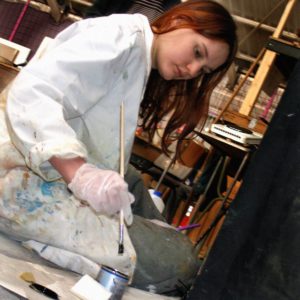 As we learned in the recent post, 10 Important Things Every Aspiring Artist Should Know: Part 1, there are some very important things that aspiring artists need to know before they strike out on their own to make it as a professional.
As we learned in the recent post, 10 Important Things Every Aspiring Artist Should Know: Part 1, there are some very important things that aspiring artists need to know before they strike out on their own to make it as a professional.
Being a professional at anything takes skill, hard work, perseverance, confidence and knowledge. I hope these two articles help arm you with some of the tools needed to make the move from an amateur to a professional artist.
#6 Contracts Can Make the Difference
As you look for the perfect artistic career, you’ll find yourself doing a lot of piecemeal contract and freelance work for extra cash. When you work on a project-by-project basis, you need to get paid promptly so that you can pay for things you might need. To make sure you always make rent, you need a solid contract.
Keep your contract straightforward, simple, and professional. Make it clear that your contract is legally binding and that payment is due within 30 days of the receipt of the invoice. Stipulate that additional penalties will accrue at X% on top of the original fee if payment is tardy beyond the 30-day mark. In most instances you can accomplish everything you need to in a short form contract. For more information on contracts for artists check this out.
#7 Know Your Value

Art is subjective. One man’s paint splatter is another man’s masterpiece. When you are trying to decide how much to charge for your work, you need to take a lot of things into account.
- First, think about the time it takes you to do something. If a piece takes you 60 hours to complete and you only charge $500 dollars for it that means you are working for about $8 an hour. That’s not a great salary for a professional artist, unless of course you are a “Sandwich Artist.”.
- Second, consider the cost of your supplies. If you spend $200 on materials for that 60-hour piece, and charge $500 dollars, you are only making $300 on the piece – which means you’re actually making about $5 an hour.
- Third, factor in the intangibles of your work that give it value. You didn’t start making art today; you’ve practiced, studied, trained, experimented, and improved for years. Factor those years of preparation into your final price. Even if you can make something in an hour, it doesn’t mean it’s less valuable because it would take a non-professional many more hours to approximate the same thing. After all, your years of practice prepared you to create quality work quickly. You should be compensated for that foresight and training.
- Fourthly, value creates value. If you charge more money for something, people will assume it is worth more money. If you make an amazing sculpture and sell it for one dollar, people will think that there must be something wrong with it. They will devalue it, even though their initial impression was that it was a lovely and valuable piece of art. There is a point where you can charge too much for your work, but charging more than you think it’s worth might actually help you sell more of it, make more money, and establish a perceived value that wasn’t there before.
#8 The Client Will Annoy You

The problem with art is that everyone assumes that they are good at it. Nuclear engineers never face this problem. If a nuclear engineer gets hired to work on a problem, they are never second-guessed about tweaking their quantum physics formulas. Why? Because the person who hired them knows they don’t know how to perform nuclear engineering, that’s why they hired a scientist.
Art is not like this. Art is more democratic—and democracies make mistakes. Everyone thinks they have a hidden talent for art, a great eye, or a subtle genius for color theory. At the very least they will assume that “they know what they like” (even if their taste is atrocious). Because of this common misconception, your client will give you advice and feedback that will annoy you. And it should annoy you, because in most cases, it will be wrong. After all, your client lacks the talent and vision to create design for him or herself. Don’t worry; this won’t stop them from piping in with ill formed opinions. He or she will try to put their touch on your design by having you add space where it isn’t needed, or mix colors that clash.
Unfortunately, until you are an established artist, you are going to have to either concede to your client’s wishes and get paid, or stay righteous and poor. The sooner you deal with this, the sooner you’ll get paid.
#9 Being an Artist Doesn’t Mean You Get to Be Irresponsible
Until you’ve made it big, your quirks and whims won’t be seen as endearing or delightfully Warholian. If you’re serious about making art your business then go ahead and put aside romantic visions of an artistic lifestyle that focuses on glamour and doesn’t put much stock in the details.
As an aspiring artist you’ll need to hustle, and you’ll need to sell yourself. You’ll need to network; you’ll need to market your skills and your portfolio. You’ll need to answer phone calls, and, just as importantly, return those calls you missed. Just because you are talented doesn’t mean you are going to make it as an artist. A combination of talent and tenacity is required to showcase your work and get it the recognition that it very well may deserve.
#10 Confidence is Required

If a stranger asks you, “What do you do?” And your response sounds something like, “Umm. Well, I um … I don’t know. Well … I want to be an artist, but I’m not really an artist, I mean I’m not that good, and I certainly don’t get paid for it, but I sure like art.”
You are not doing a good job of being an artist. No matter how amazing your artwork is, if you can’t project an aura of confidence and professionalism it is going to take a series of miracles for anyone to ever get the chance to see and appreciate your work. Yes, the universe is unfair, there are some artists with little talent beyond self-promotion that are famous. Do they deserve to be famous? Not really, but the point is that confidence and self-promotion can be as important, if not more important, than talent.
The majority of successful professional artists exhibit a combination of confidence and talent. They recognize an opportunity and they know how to present themselves and their work to seize that opportunity. If you don’t think your art is good enough to talk about, stop now, because nobody else will either.
*****
Thanks to ArtBistro.com for sharing another great post!
…maybe you have another ‘thing‘ in mind that every aspiring artist should know, if so, please share your comment! Thanks, ~Lori 🙂
*****
I hope you find these other great articles helpful for your own creative journey!
How to Prepare for Gallery Night: Tips & Advice
Newsletter Art Marketing Tips That Work!
Commissioned Art – Tips to make it a Success!
10 tips to Bring Visitors to Your Open Studio or Art Fair Booth
Learn the Two Biggest Mistakes Artists Make with Social Media
One Simple and Effective Way to Show the World You are a Pro
5 Small Business Mistakes To Avoid









Thanks for the emerging artist tips… I certainly can relate to the “Artist” label. I still work as a Teacher Aide and find it difficult to tell people I’m an Artist…. I have my own online colouring ClickNColour website…. a very successful Art Alphbet that has artwork within each letter, custom art commissions, art gallery displays and very soon going into the Apple Ipad App area….. but still I’m a Teacher Aide. I think sometimes people my think…. ‘what the’ when one part of your life starts to be more successful than the other…. that’s when I will call myself a professional artist…. takes confidence.
Hello Debbie, and thanks for sharing your personal story with us here.
I can totally relate. When I started painting over 20 years ago, I sold my paintings right away…but, I still didn’t feel worthy of calling myself ‘an artist’ even though I was selling my art. For me, that label took meant more than just a few sales. I still lacked the confidence. Once, I began to consistently create good to great paintings, I became comfortable…and eventually the label, ‘artist’.
Keep creating and build your confidence! It will come.
Lori 🙂
Thanks for Part II!
I don’t consider myself a professional artist yet but I definitely call myself an artist. I started selling my first paintings when I was 16 and had exhibitions back in Germany and always did some commissional work on the side. But now, I am working on making a living from my artwork and stepped out of my professional career as an Exec. Chef. It’s so exciting to become a professional artist! Your two part series helped a lot to check if I am still on track and if I am still going to where I want to be.
Here’s a few more things I would like to add:
Never stop learning! Learn how to use social media for marketing, see how and what other artists are doing, learn different techniques, be open to experiment, de- and refine your style and be unique.
Good luck to all those creative souls out there and thanks to you Lori,
Franziska San Pedro
@FlavorDesigns
Great Articles (Part 1 & 2), thanks so much Lori,
I look at your articles regularly as you offer informed advice and guidance for artists like me trying to launch their careers as artists.
I am just wondering, have you written any articles about artists who have run a successful business (any business) and also sell their art? I am curious to hear success stories to learn from other peoples experience and how they do it…
Lori, I am planning and forming strategies to open my first business : Art School and Gallery. I’m tired of working for other people and I want to try and support young artists by opening and art school and gallery. I’m an art teacher who would rather profit from my skills in art and teaching rather than having a “job” in a school…BUT I still want to sell my artwork have a career as a painter at the same time …. With careful planning and being business savvy, do you think this is possible?
Would love to hear yours and others opinions.
Regards,
Sari Cecilia
Hello Sari,
I really am glad you are enjoying my articles. They even help me! Your suggestion is a good one and I have asked a few artists who juggle 2 careers to share a post on the subject. I hope to have something for you within a month. Meanwhile, I am juggling 2 careers myself and probably should write about own experience. Thanks for the thought!
I commend you on your new Art School and Gallery endeavor and wish you well. This is a nobel project especially since the Arts have suffered so many cutbacks in the schools, etc. Yes, you can have it all! I truly believe that. But, it will take a lot of perseverance, as well as sound business skills and talent to make it all happen. Let me know if you have any other questions. And, meanwhile…I will work on that post.
Happy creating-
Lori